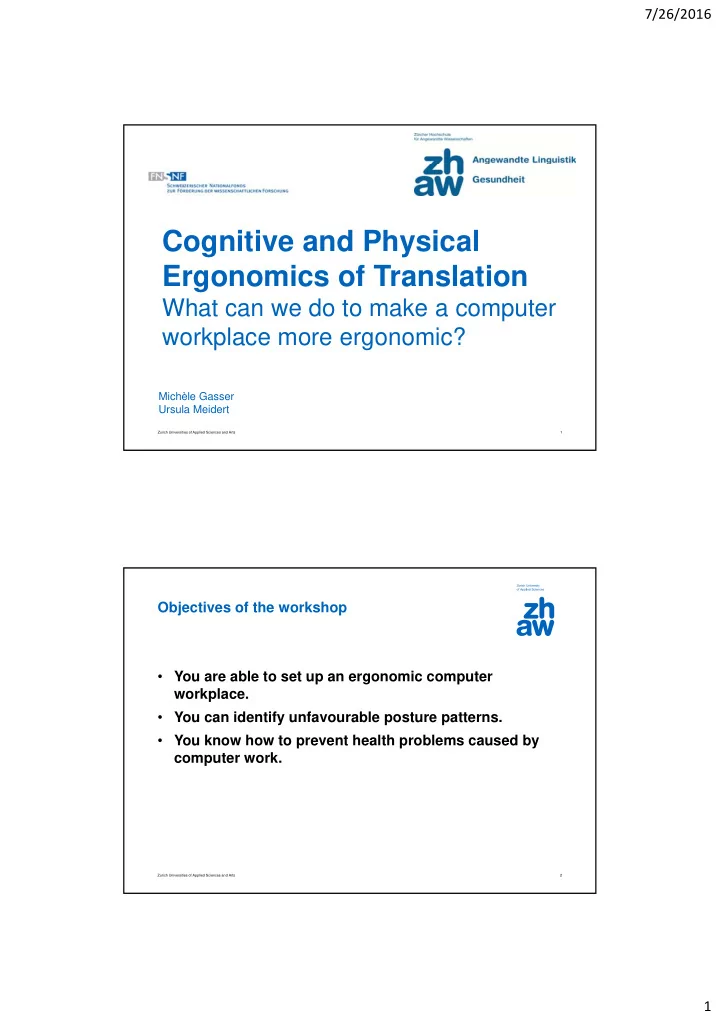

7/26/2016 Cognitive and Physical Ergonomics of Translation What can we do to make a computer workplace more ergonomic? Michèle Gasser Ursula Meidert Zurich Universities of Applied Sciences and Arts 1 Objectives of the workshop • You are able to set up an ergonomic computer workplace. • You can identify unfavourable posture patterns. • You know how to prevent health problems caused by computer work. Zurich Universities of Applied Sciences and Arts 2 1
7/26/2016 Burdens of a computer workplace What’s the challenge? The main challenge for professional translators is the one-sided strain! Translators – just like many other people in the service industry – sit most of their working time in front of a screen without a lot of change in their posture. • The physical load on the body during the day remains the same. • This one-sided strain can cause problems especially when the workplace is not set-up ergonomically or if the translator has poor posture. Zurich Universities of Applied Sciences and Arts 4 What can we do to prevent health problems? Environment Person Ergonomic adaptations “Healthy” behaviour • Adaptation of the work • Body: Good physical condition to the abilities state and posture, regular of the person. exercise • The aim is to optimize the • Behaviour at work: work conditions to regular breaks, changing minimize the health working position, … burdens. Zurich Universities of Applied Sciences and Arts 5 2
7/26/2016 Set up a computer workplace in theory and practice Method • Theoretical input • Practical demonstration • Examples from practice with pictures from the ErgoTrans project Zurich Universities of Applied Sciences and Arts 6 Lighting Position of the screen in the room: The screen should be positioned so that the light comes from the side. This will prevent reflections and glare. Window/light: The light should always be indirect. The line of sight should be parallel to the window. Zurich Universities of Applied Sciences and Arts 7 3
7/26/2016 Adjusting table and chair Chair height: The feet should be flat on the floor. Knees and hips should have an angle of at least 90°. Important for posture and blood circulation. Table height: When sitting upright in the chair, arms should rest on the table (90° angle). Picture: http://www.ekas-box.ch/en/#!/home Zurich Universities of Applied Sciences and Arts Footrest Footrest: Should be used if the table is not adjustable and/or the feet do not reach the floor. It is better to adjust the table and chair if possible. Picture: http://www.ekas-box.ch/en/#!/home Zurich Universities of Applied Sciences and Arts 9 4
7/26/2016 Chair Seat: the back should press lightly against back of the chair. There should be a gap between the knees and the seat of at least two fingers. Chair back: Should be flexible to lean back and still provide enough resistance to support the back. Picture: http://www.ekas-box.ch/en/#!/home Zurich Universities of Applied Sciences and Arts 10 Chair Lumbar support: Office chairs have a curved chair back. The curve should support the lumbar lordosis correctly. Armrests: When sitting upright the elbows should rest lightly on the armrests (angle of at least 90°). Armrests are not a necessity. Picture: http://www.ekas-box.ch/en/#!/home Zurich Universities of Applied Sciences and Arts 11 5
7/26/2016 Screen Position: straight in front of the person. Distance: Between the eyes and the screen should be at least one arm’s length (around 27.5-35.5 Inches). Height: top of the screen should be one hand width below the level of the eyes. Picture: http://www.ekas-box.ch/en/#!/home Zurich Universities of Applied Sciences and Arts 12 Screens Examples from practice Zurich Universities of Applied Sciences and Arts 13 6
7/26/2016 Keyboard and mouse Keyboard: Keyboard should be directly in front of the person. The distance to the edge of the table should be between 4-6 Inches (10-15 cm), so that the heels of the hands can rest on the table. Mouse: Should be as close as possible to the keyboard. Picture: http://www.ekas-box.ch/en/#!/home Zurich Universities of Applied Sciences and Arts 14 Keyboard Examples from practice Zurich Universities of Applied Sciences and Arts 15 7
7/26/2016 Mouse Examples from practice • Reaction of the mouse is too slow, resulting in big movements. • Mouse is too far away from the body. • Wrist should be straight in line with the arm. Zurich Universities of Applied Sciences and Arts 16 Keyboard without number key pad Possible aid Keyboard: Enables to work with the mouse closer to the body • Less stress for the shoulder • (and for the wrist) • If you have to enter lots of numbers it should have a number key pad. Zurich Universities of Applied Sciences and Arts 17 8
7/26/2016 Light Light (window or office light) should never come from the front or the back of the monitor or directly above the head (glare or reflection). Light sources should always come from the side and should be individually adjustable. Picture: http://www.ekas-box.ch/en/#!/home Zurich Universities of Applied Sciences and Arts 18 9
Recommend
More recommend